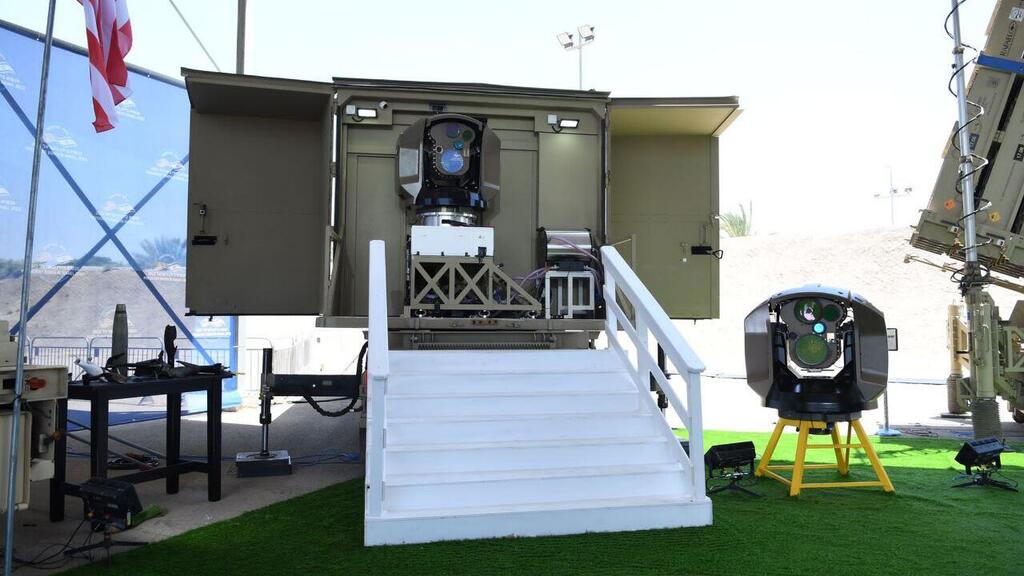Getting your Trinity Audio player ready...
“This is the first laser system of its kind in the world, a global breakthrough—not just for Israel—that allows us to intercept missiles, rockets, shells, and drones kilometers away from the country using lasers,” said former minister and Rafael Chairman Yuval Steinitz on Sunday.
The timing of the announcement amid wartime holds special significance, he noted: “Most of our employees at Rafael are highly skilled scientists who could work elsewhere, but here, they feel they’re contributing to the national effort.”
Israel’s Defense Ministry announcement effectively ends an international race among world powers, who have spent years attempting to develop a laser-based defense system. This breakthrough was made possible by scientific advancements at Rafael six years ago, which allowed the laser beam to stay consistent upon contact with the atmosphere without scattering. Rafael expects the system to be operational by 2025, adding another layer to Israel’s air defense against missile threats during wartime.
Drone intercepts
(IDF)
“The system is composed of hundreds of laser beams directed at an incoming target,” Steinitz explained. “Laser is a highly focused and powerful beam with immense energy that can cut through steel at close range. However, when it encounters air, it tends to scatter. Our scientists at Rafael solved this by sending hundreds of laser beams toward a target tens of kilometers away, enabling us to detect in seconds—based on the beams' return—which hit the missile most accurately. The system then instantly redirects all beams to that precise point for effective targeting. It happens in a flash, within milliseconds. Once all beams lock onto the most accurate frequency, the missile can be neutralized.”
Using sophisticated targeting technology similar to Iron Dome’s advanced systems, the laser system calculates the most effective beam for detonating the incoming missile, focusing the rest of the beams on that exact impact point to bring it down. “The hit range will be about 10 centimeters,” Steinitz noted. “It will slice through the missile’s steel casing, penetrate its warhead, and strike the explosive with such force that it will detonate.”
When fully operational, the Iron Beam system will complement Israel’s existing air defense network, already one of the most advanced globally thanks to Iron Dome, the Arrow missile, and David’s Sling. This laser-based system provides Israel with a strategic and economic advantage, reducing interception costs significantly. “Right now, each interceptor missile costs taxpayers a fortune,” Steinitz explained. “But the Iron Beam intervention will cost the state only a few thousand dollars per use, thanks to the laser-based system instead of missiles. It’s a major difference. The cost of a single interception will be around five dollars, a massive shift. It reverses the current equation of intercepting cheap missiles with expensive countermeasures.”
Rafael declined to go into further details, but for now, it appears the system won’t defend against ballistic missile attacks, like the one seen from Iran earlier this month. However, Rafael assures it will work effectively against other aerial threats from neighboring regions that have intensified in recent years. “The system will be deployed alongside Iron Dome batteries,” Steinitz added, “and depending on the threat type, it will decide whether to use an Iron Dome missile or the faster, lower-cost laser to do the job.”
According to the agreement, the first operational system will be delivered to Israel by the end of next year. Like any defense system developed here, Israel’s adversaries will immediately seek ways to overcome it. Yet Steinitz remains unfazed by the challenge. “There’s never 100 percent success, but while they think far ahead, so do we—ten steps ahead. This is just the beginning of the system. It’s clear that this breakthrough will bring additional applications and have a lasting impact on national defense in the future,” he concluded.
Get the Ynetnews app on your smartphone:







